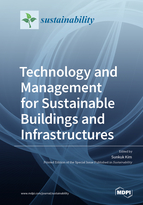Technology and Management for Sustainable Buildings and Infrastructures
A special issue of Sustainability (ISSN 2071-1050). This special issue belongs to the section "Sustainable Engineering and Science".
Deadline for manuscript submissions: closed (28 February 2021) | Viewed by 107013
Special Issue Editor
Interests: sustainable construction project management; energy use and CO2 reduction in construction project; performance evaluation of buildings and infrastructures; simulation and optimization; risk management; free-form building technology; sustainable facility management
Special Issues, Collections and Topics in MDPI journals
Special Issue Information
Dear Colleagues,
Sustainability has been being used in a variety of areas, including human activities, economics and management, climate and environment, and national policy since the Roman Club first mentioned it in 1972 in the report “The Limits to Growth”. According to UNEP, buildings use about 40% of the global energy, 25% of the global water, 40% of the global resources, and they emit approximately one-third of greenhouse gas emissions. Yudelson (2007) argued that buildings produce 45% to 65% of disposed waste in landfills. Enormous resources are invested in the construction and operation of various infrastructure to run cities and industries, and energy is correspondingly used. Excessive use of energy is an immoral act that places a heavy burden on future generations.
Therefore, research on the technology and management of the entire process from design, procurement, construction, O&M, and decommissioning is needed to produce sustainable buildings and infrastructure that minimize energy use throughout their life cycle. This Special Issue aims to act as a research hub for exchanging research on innovative technology and management on sustainable buildings and infrastructure. This Special Issue is expected to contribute to the sustainability of buildings and infrastructure, which most impacts climate change. This Special Issue encourages the submission of case study papers, as well as academic and practical research, with focuses on the keywords listed below.
- Sustainable buildings and infrastructure
- Sustainable construction technology
- Energy use or CO2 emission reduction
- Life cycle assessment
- Simulation, optimization, and risk management
- Sustainable facility management
- Modeling techniques for the sustainability of buildings and infrastructure
- Policies and regulations for sustainable buildings and infrastructure
Original papers related to the above keywords or considering innovative technologies, management techniques, experimental investigations, mathematical and logical algorithms, policies and regulations, and case studies for sustainable buildings and infrastructures are also welcome.
Prof. Sunkuk Kim
Guest Editor
Manuscript Submission Information
Manuscripts should be submitted online at www.mdpi.com by registering and logging in to this website. Once you are registered, click here to go to the submission form. Manuscripts can be submitted until the deadline. All submissions that pass pre-check are peer-reviewed. Accepted papers will be published continuously in the journal (as soon as accepted) and will be listed together on the special issue website. Research articles, review articles as well as short communications are invited. For planned papers, a title and short abstract (about 100 words) can be sent to the Editorial Office for announcement on this website.
Submitted manuscripts should not have been published previously, nor be under consideration for publication elsewhere (except conference proceedings papers). All manuscripts are thoroughly refereed through a single-blind peer-review process. A guide for authors and other relevant information for submission of manuscripts is available on the Instructions for Authors page. Sustainability is an international peer-reviewed open access semimonthly journal published by MDPI.
Please visit the Instructions for Authors page before submitting a manuscript. The Article Processing Charge (APC) for publication in this open access journal is 2400 CHF (Swiss Francs). Submitted papers should be well formatted and use good English. Authors may use MDPI's English editing service prior to publication or during author revisions.
Keywords
- Buildings and infrastructure
- Sustainability
- Technology and management
- Energy use
- CO2 reduction
- Life cycle assessment
- Facility management
- Simulation
- Optimization
- Risk management
- Modeling techniques
- Policy






